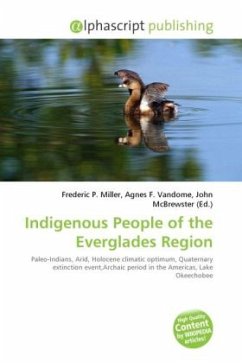
Indigenous People of the Everglades Region
Versandkostenfrei!
Versandfertig in 6-10 Tagen
30,99 €
inkl. MwSt.

PAYBACK Punkte
15 °P sammeln!
High Quality Content by WIKIPEDIA articles! The indigenous people of the Everglades region arrived in the Florida peninsula approximately 15,000 years ago, probably following large game. The Paleo-Indians found an arid landscape that supported plants and animals adapted to desert conditions. Climate changes 6,500 years ago brought a wetter landscape; large animals became extinct in Florida, and the Paleo-Indians slowly adapted to the new conditions. Archaeologists call the cultures that resulted from the adaptations Archaic peoples. They were better suited for environmental changes than their ...
High Quality Content by WIKIPEDIA articles! The indigenous people of the Everglades region arrived in the Florida peninsula approximately 15,000 years ago, probably following large game. The Paleo-Indians found an arid landscape that supported plants and animals adapted to desert conditions. Climate changes 6,500 years ago brought a wetter landscape; large animals became extinct in Florida, and the Paleo-Indians slowly adapted to the new conditions. Archaeologists call the cultures that resulted from the adaptations Archaic peoples. They were better suited for environmental changes than their ancestors, and created many tools with the resources they had. Approximately 5,000 years ago, the climate shifted again to cause the regular flooding from Lake Okeechobee that became the Everglades ecosystems. From the Archaic peoples, two major tribes emerged in the area: the Calusa and the Tequesta. The earliest written descriptions of these people come from Spanish explorers who sought toconvert and conquer them












